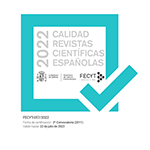Use of machine learning to establish limits in the classification of hyperaccumulator plants growing on serpentine, gypsum and dolomite soils
Abstract
The so-called hyperaccumulator plants are capable of storing hundred or thousand times bigger quantities of heavy metals than normal plants, which makes hyperaccumulators very useful in fields such as phytoremediation and phytomining. Among these plants there are many serpentinophytes, i.e., plants that grow exclusively on ultramafic rocks which produce soils with a great proportion of heavy metals. Even though there are multiple classifications, the lack of consensus regarding which parameters to use to determine whether a plant is a hyperaccumulator, as well as the arbitrariness of stablished thresholds, bring about the need to propose more objective criteria. To this end, plant mineral composition data from different vegetal species were analysed using machine learning techniques. Three complementary case studies were established. Firstly, plants were classified in three types of soils: dolomite, gypsum and serpentine. Secondly, data about normal and hyperaccumulator plant Ni composition were analysed with machine learning to find differentiated subgroups. Lastly, association studies were carried out using data about mineral composition and soil type. Results in the classification task reach a success rate over 75%. Clustering of plants by Ni concentration in parts per million (ppm) resulted in four groups with cut-off points in 2.25, 100 (accumulators) and 3000 ppm (hyperaccumulators). Associations with a confidence level above 90% were found between high Ni levels and serpentine soils, as well as between high Ni and Zn levels and the same type of soil. Overall, this work demonstrates the potential of machine learning to analyse data about plant mineral composition. Finally, after consulting the red list of the IUCN and those of countries with high richness in hyperaccumulator species, it is evident that a greater effort should be made to establish the conservation status of this type of flora.
Downloads
Article download
License
Mediterranean Botany is an open access journal to promote global exchange knowledge. It facilitates unrestricted access to its contents from the moment of publication in its electronic edition. The originals published are property of the Universidad Complutense and it is mandatory to cite such source in case of total or partial reproduction. All contents are distributed under a Creative Commons License 4.0 (CC BY 4.0). This circumstance must be expressly stated in this way when necessary. You can check the informative version and legal text of the license.














